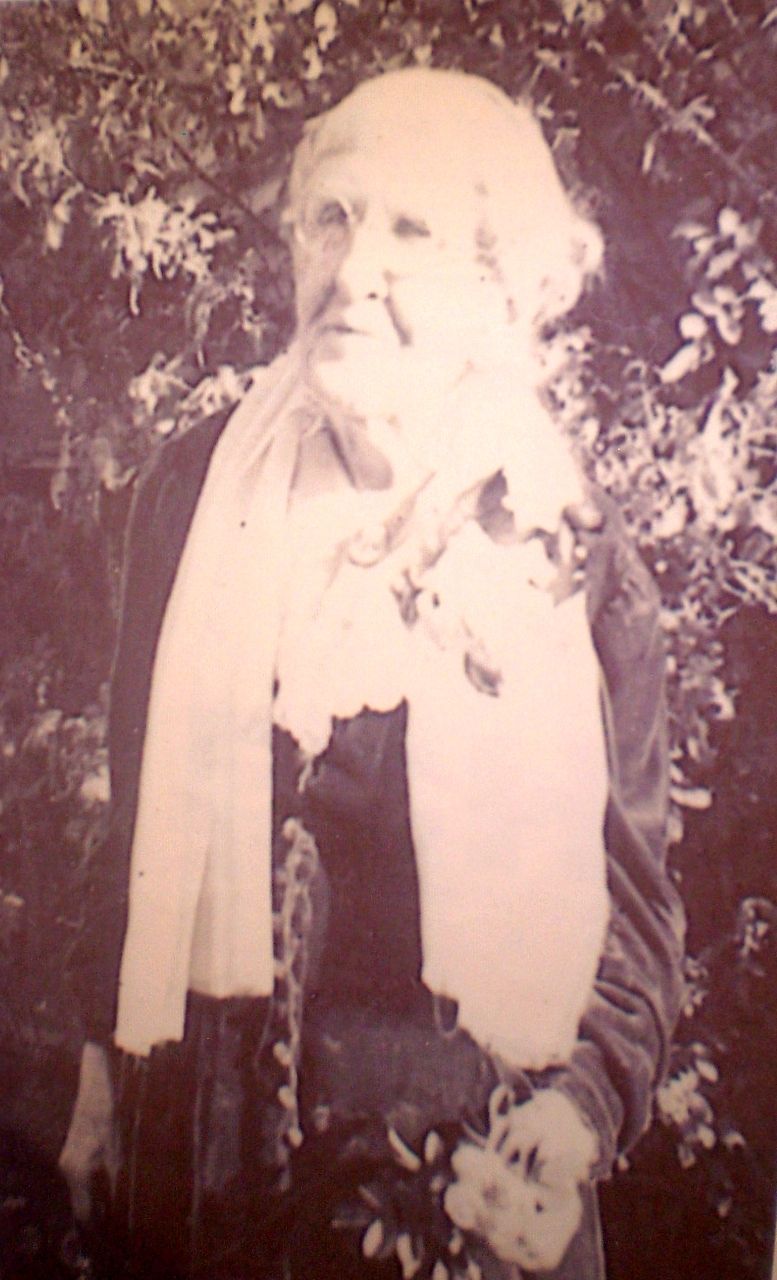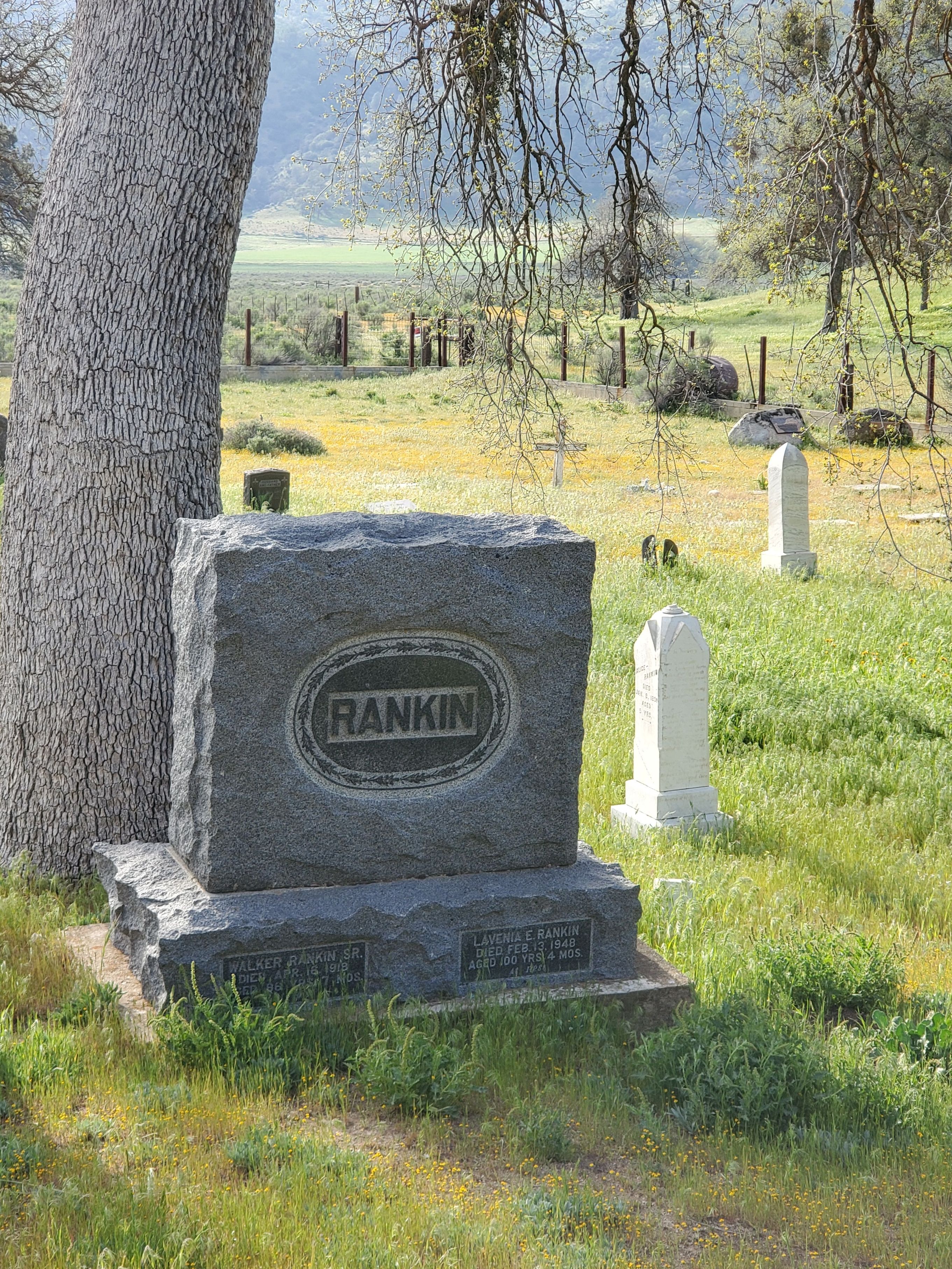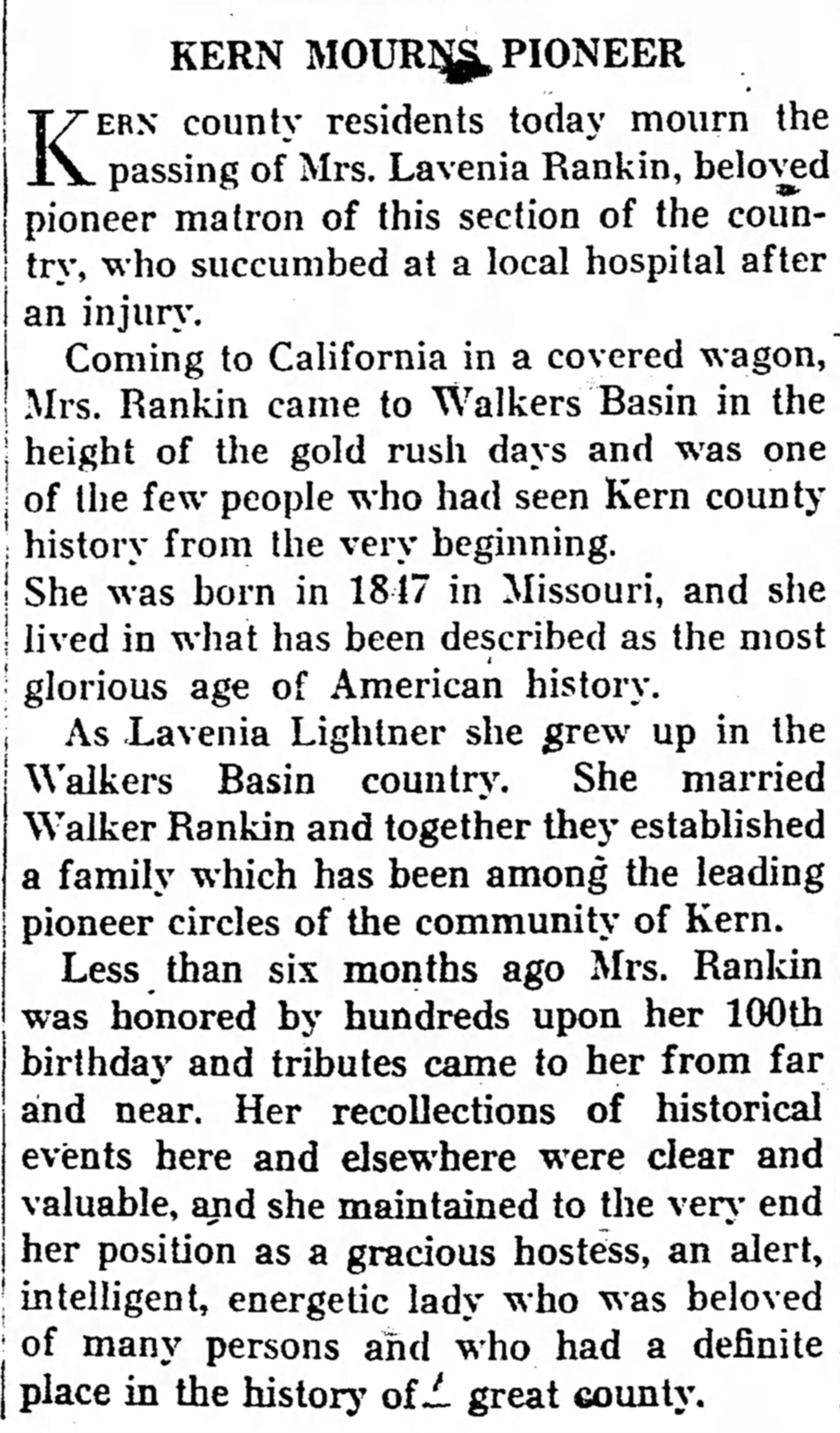Lavenia married Walker Rankin Sr. on 17 Sep 1868 at the Lightner Ranch in Walker Basin. They had 7 children: Charles, Warren, Leroy, Edward "Ned", Jesse, Alice, Walker Jr.
Lavenias was nicknameed "Bebe" by her brothers, later called Aunt Bebe and Nana.
She was a toddler when she raveled to california across the plains and lived to be over 100 yearsold. Her life was full of accomplishments and one of the most treasured was the records that she kept of her experiences and those of the Lightner family. It is not only entertaining as a story, but also an authentic document depicting life as it existed in mining and cattle country following the great gold tush of '49, and gives highlights of the century's history of the Kern River and Walker Basin.
She was three years old when the family reached San jose but felt her mother's apprehension about the unrest of the times after the Mexican/U.S. War of 1846-48. Here was where schooling and church services started for her until she was 8 and the family moved to Keysville. The indians against whose attack the wagons were circled nightly coming across the plains, became a reality. They came to her father's store, were treated kindly, and responded in kind. Chief Chico's daughters were named after Bebe and mary, her sister. Church and schooling were at the family fireside in Keysville. She saw the roughest of brawling times in California History with long haired men, flour sack patches and gold dust.
This little girl had descended the "Old Bull Road" down the eastern slope of Greenhorn into Keysville, over a mere suggestion of a road in her father's horse drwan wagon. A. T. Lightner was reported the first to bring his family over the ox road with horses. She took the miners and the Bull Road in stride but she showed great excitement at seeing a pack train arrive at the Marsh and kennedy Store.
When she was 11, the family settled in Walker Basin and she was ecstatic and very descriptive of the beauty of her new valley. Lavenia and Mary planted locust trees and lilacs in from of their home. They served as friendly reminders to her until her parting and still defy time. They herald the graciouness of the family and it was in front of the lilac that Bebe and Mary were married as well as family members after them. Lavenis saw Havilah come into being as she wrote to her uncle, daniel Snelling in 1859 about the thriving conditions and improved closer market for the Basin people. "The wild indians would come into the firlds, lie down on their stomachs and eat clover like cattle. They would gather the wild rye in quantities and grind it into meal in holes in the rocks and make it into a mush."
Lavenis observed these primitive peoples whose village was near the Lightner Ranch, living in peace, responding to her family's generous treatment. She witnessed atrocities in the advent of the Indian War of 1863 and the subsequent unrest between the Indians and White men. As time passed she saw indians join her father's work crews and later some of their children were attending school with hrs. The Civil War (1861-1865) was felt by this young girl as Confederate Soldiers passed through, often stopping at her parents to buy meals. As the Lightners were known southern sympathizers, ther was some apprehension but the officers maintained courtesy from their men. She saw her mother receive her first stove and the first in the Basin though it was damaged from a tumble out of the wagon. The roads out of the Basin were non-existent at the time, thus the wagons were hoisted up steep hills by pulleys. Cooking for the family had been done in the fireplace with pots suspended from hooks. "My mother was happy to have that stove", she wrote. havilah became the County Seat in 1866 and the first school in the county was formed. At the age of 20 (1867) Lavenia went to school in Havilah to father Dade with Ida and Laura Dunlap from Linn's Valley. After 20 days, Jemima spilled hot suds on her foot, thus Lavenia went home to care for her. Abia was killed this same year. In 1868 Bebe married Walker Rankin. They lived in the home he purchased from Dan and mary Walser, the Mayberry Place, for a few years. The first two boys were born there. Walker constructed a two-story home at the foot of Rankin Hill on the main road to Havilah. In 1867 cal Baker completed the Baker Toll Road connecting Kern Island to havilah via Walker Basin. Lavenia became well aware of the effect of this trough road on their lives. Their ranch became a teamster's stop, their dining table a restraurant and their home, a hotel. She found a new joy and that was seeing that these hungry men eat as her table groaned with food three times a day with as many as forty servings per meal at times. The gold from the Keysville mines was being shipped our over this new route which attracted robbers and famous gangs. Lavenis met the Vasques gang as they stopped at the ranch for food. She also met Joaquin Murietta and supplied their needs without questions and no harm was done them. The hardest earthquake known which was in 1872 was described by Lavenia. In 1874 the railroad was brought through Caliente, formerly called Allen's camp, resulting in daily mail and stage service from Kernville to Caliente via Walker Basin. this same year saw the completion of the Oyler Canyon Road to Caliente, which was much shorter than the Baker road. Nana Rankin saw the irst school started in 1877 thus her children attended just a mile from home. In 1906 owever, Walker was ready for High School and nana purchased a home on D street in Bakersfield. They took "Ole Brownie" and the buggy which required them to have a stable at their home in order to have transportation. 1912 brought a new excitement, the first motorized stage coach and the growing popularity of the motor car. By 1915 Walker had purchased one for Lavenia and her life was truly revolutionized. She kept a driver as she felt at 68 years old was past time to learn to drive and travel became her great pleasure. This gentlewomen was a source of love and assistance for all who washed upon her shores. She was supportive to the Baptist Church where a large stained glass was at the entrance in memory of Jemima Sharp Snelling Lightner. She loved her babies and her children's babies and had a knack for comforting them. She had numerous qualities to be admired but perhaps the greatest was that she did not complain. She was loved and admired and respected by everyone.
This is to verify any information
https://www.familysearch.org/tree/person/details/LCJ7-LK9
Information may not be 100% correct. I based information from FS. if anything needs to be corrected please send me a suggestion. Thank you
Lavenia married Walker Rankin Sr. on 17 Sep 1868 at the Lightner Ranch in Walker Basin. They had 7 children: Charles, Warren, Leroy, Edward "Ned", Jesse, Alice, Walker Jr.
Lavenias was nicknameed "Bebe" by her brothers, later called Aunt Bebe and Nana.
She was a toddler when she raveled to california across the plains and lived to be over 100 yearsold. Her life was full of accomplishments and one of the most treasured was the records that she kept of her experiences and those of the Lightner family. It is not only entertaining as a story, but also an authentic document depicting life as it existed in mining and cattle country following the great gold tush of '49, and gives highlights of the century's history of the Kern River and Walker Basin.
She was three years old when the family reached San jose but felt her mother's apprehension about the unrest of the times after the Mexican/U.S. War of 1846-48. Here was where schooling and church services started for her until she was 8 and the family moved to Keysville. The indians against whose attack the wagons were circled nightly coming across the plains, became a reality. They came to her father's store, were treated kindly, and responded in kind. Chief Chico's daughters were named after Bebe and mary, her sister. Church and schooling were at the family fireside in Keysville. She saw the roughest of brawling times in California History with long haired men, flour sack patches and gold dust.
This little girl had descended the "Old Bull Road" down the eastern slope of Greenhorn into Keysville, over a mere suggestion of a road in her father's horse drwan wagon. A. T. Lightner was reported the first to bring his family over the ox road with horses. She took the miners and the Bull Road in stride but she showed great excitement at seeing a pack train arrive at the Marsh and kennedy Store.
When she was 11, the family settled in Walker Basin and she was ecstatic and very descriptive of the beauty of her new valley. Lavenia and Mary planted locust trees and lilacs in from of their home. They served as friendly reminders to her until her parting and still defy time. They herald the graciouness of the family and it was in front of the lilac that Bebe and Mary were married as well as family members after them. Lavenis saw Havilah come into being as she wrote to her uncle, daniel Snelling in 1859 about the thriving conditions and improved closer market for the Basin people. "The wild indians would come into the firlds, lie down on their stomachs and eat clover like cattle. They would gather the wild rye in quantities and grind it into meal in holes in the rocks and make it into a mush."
Lavenis observed these primitive peoples whose village was near the Lightner Ranch, living in peace, responding to her family's generous treatment. She witnessed atrocities in the advent of the Indian War of 1863 and the subsequent unrest between the Indians and White men. As time passed she saw indians join her father's work crews and later some of their children were attending school with hrs. The Civil War (1861-1865) was felt by this young girl as Confederate Soldiers passed through, often stopping at her parents to buy meals. As the Lightners were known southern sympathizers, ther was some apprehension but the officers maintained courtesy from their men. She saw her mother receive her first stove and the first in the Basin though it was damaged from a tumble out of the wagon. The roads out of the Basin were non-existent at the time, thus the wagons were hoisted up steep hills by pulleys. Cooking for the family had been done in the fireplace with pots suspended from hooks. "My mother was happy to have that stove", she wrote. havilah became the County Seat in 1866 and the first school in the county was formed. At the age of 20 (1867) Lavenia went to school in Havilah to father Dade with Ida and Laura Dunlap from Linn's Valley. After 20 days, Jemima spilled hot suds on her foot, thus Lavenia went home to care for her. Abia was killed this same year. In 1868 Bebe married Walker Rankin. They lived in the home he purchased from Dan and mary Walser, the Mayberry Place, for a few years. The first two boys were born there. Walker constructed a two-story home at the foot of Rankin Hill on the main road to Havilah. In 1867 cal Baker completed the Baker Toll Road connecting Kern Island to havilah via Walker Basin. Lavenia became well aware of the effect of this trough road on their lives. Their ranch became a teamster's stop, their dining table a restraurant and their home, a hotel. She found a new joy and that was seeing that these hungry men eat as her table groaned with food three times a day with as many as forty servings per meal at times. The gold from the Keysville mines was being shipped our over this new route which attracted robbers and famous gangs. Lavenis met the Vasques gang as they stopped at the ranch for food. She also met Joaquin Murietta and supplied their needs without questions and no harm was done them. The hardest earthquake known which was in 1872 was described by Lavenia. In 1874 the railroad was brought through Caliente, formerly called Allen's camp, resulting in daily mail and stage service from Kernville to Caliente via Walker Basin. this same year saw the completion of the Oyler Canyon Road to Caliente, which was much shorter than the Baker road. Nana Rankin saw the irst school started in 1877 thus her children attended just a mile from home. In 1906 owever, Walker was ready for High School and nana purchased a home on D street in Bakersfield. They took "Ole Brownie" and the buggy which required them to have a stable at their home in order to have transportation. 1912 brought a new excitement, the first motorized stage coach and the growing popularity of the motor car. By 1915 Walker had purchased one for Lavenia and her life was truly revolutionized. She kept a driver as she felt at 68 years old was past time to learn to drive and travel became her great pleasure. This gentlewomen was a source of love and assistance for all who washed upon her shores. She was supportive to the Baptist Church where a large stained glass was at the entrance in memory of Jemima Sharp Snelling Lightner. She loved her babies and her children's babies and had a knack for comforting them. She had numerous qualities to be admired but perhaps the greatest was that she did not complain. She was loved and admired and respected by everyone.
This is to verify any information
https://www.familysearch.org/tree/person/details/LCJ7-LK9
Information may not be 100% correct. I based information from FS. if anything needs to be corrected please send me a suggestion. Thank you
Gravesite Details
Wife of Walker Rankin, Sr
Family Members
Sponsored by Ancestry
Advertisement
Advertisement

























